empower children's creativity and inventiveness, particularly in the
outdoor environment. Nicole Weinstein gives some tips.

Children's imaginations thrive when they are given the chance to play with open-ended materials that have no specific purpose. Take a cardboard box, for instance, which might become a rocket, a tent or a bus. Playing with 'loose parts' such as this, along with water, sticks, sand and ropes, allows children to be more creative than they would be playing with a fixed-purpose toy such as a small-world car.
This type of play also allows the child to have greater control over their play and is why practitioners should not overlook the endless possibilities that come with giving children a vast selection of natural and synthetic loose parts, particularly in the outdoor environment.
WHAT ARE LOOSE PARTS?
Loose parts in early years settings are materials that children can move around, adapt, control, change and manipulate within their play.
Examples in the outdoor environment include materials they can find, such as stones, twigs, gravel, flowers or leaves, and resources provided for them - stumps, sand, fabric, wood, pallets, balls, buckets, baskets, crates, boxes, logs, rope, tyres, balls, shells and seedpods.
The theory of loose parts was coined by architect Simon Nicholson in 1971, who argued that loose parts in our environment help empower our creativity and inventiveness. He suggested that a beach is a good example of a loose parts environment, with plenty of moveable and adaptable materials, such as sand, water, rocks and shells. His work has had an increasing influence on play experts and play area designers.
THE BENEFITS FOR CHILDREN
Niki Willows, an outdoor play consultant based in Wiltshire, says loose parts are essential for adding 'depth and richness' to play. She explains, 'They are the pieces that encourage the magic to happen. If all children are given set toys with a specific outcome, you're only going to get that outcome. For example, a slide outside is a great piece of physical equipment, but add a curtain and a couple of tent pegs and it's a whole new world. Children need items to manipulate and move around to encourage them to use their imagination.'
Often these materials can be found or recycled - see Cosy Direct's 'Free Play for Free' poster for inspiration - but it is important that a wide array of resources is provided and that they are changed and added to regularly.
Storing these resources so that children can access them easily themselves is vital for promoting independent play. The open-ended nature of these materials makes them an intrinsically creative resource as children can use them however they want with no set agenda, directing their own play. These resources promote imagination, physical dexterity, creative thinking and collaborative play, and enable children to shape their play without adult direction.
HOW TO USE LOOSE PARTS
Loose parts are springboards for children's play. Children have a natural ability to decide how to use objects and materials in their play, and it is advised that the adult's role is to facilitate the play and observe how it develops, rather than constantly intervening and directing it.
Juliet Robertson, an education consultant specialising in outdoor learning and play, says that when children play in a space or with an object, they experience it in a 'unique way'. She explains, 'They view it in terms of its "affordances", rather than its common use. The affordances of an object or space are all the things it has the potential to do or be. A table, for example, offers the child a jumping deck; if turned upside down, a boat; and, if on its side, a protective wall that becomes part of a fort. It may take a very open mind on our part - there is often a bit of mess and mud - but when children use play materials and areas in creative ways, it is our responsibility to support and encourage their work and ideas.'
However, some parents may wonder why children are playing with such a diverse range of materials. Ms Robertson says, 'It's not just a case of dumping a load of loose parts into the playground and letting the children get on with it. Staff and parents need to be educated on the value of loose parts play. Practitioners then need to introduce the loose parts to the children in small, group-play sessions, which allow routines around their use to be developed.'
Good videos to kickstart this process include:
- Scrapstore PlayPods in Action (www.playpods.co.uk) - at www.youtube.com/watch?v=nqi1KyJJeKg
- Imagination Playground in a Box (www.imaginationplayground.com) - at www.youtube.com/watch?v=WMwp_76_We4
- Natural Play in Schools by Grounds for Learning (www.ltl.org.uk/scotland) - at tinyurl.com/mufzpjy
HEALTH AND SAFETY
Staff will need to carry out a risk assessment of the materials to ensure they are suitable for the children's use. Planks of wood with sharp edges or splinters might need to be sanded down; wires to be removed from computer keyboards; and nails or staples extracted from pieces of wood or furniture.
Ms Robertson says, 'Every setting that introduces or uses loose parts should put procedures in place for their management and use. This is best created through shared discussions with staff, children and parents and carers, and which consider the benefits as well as the risks of using loose parts. Some nurseries and schools have such play policies and risk benefit assessments. This sits within the guidance contained in the Managing Risk in Play Provision document.' (See www.playengland.org.uk/media/172644/ managing-risk-in-play-provision.pdf)
TOP OUTDOOR LOOSE PARTS RESOURCES
Here is a list of key resources for building up an outdoor collection of loose parts:
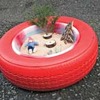 Tyres - can be rolled around, stacked or filled up; sat, hidden or jumped in; used as planters, be climbed on and used in many other creative ways. Ask local mechanics if they have any old tyres that they could donate, or buy a pack of four Tyres (£24.99); a pack of two Lorry Tyres (£95); a Tyre Track of 32 tyres (£120); or a Tyre Bowl (£9.99), all from Cosy Direct on 01332 370152.
Tyres - can be rolled around, stacked or filled up; sat, hidden or jumped in; used as planters, be climbed on and used in many other creative ways. Ask local mechanics if they have any old tyres that they could donate, or buy a pack of four Tyres (£24.99); a pack of two Lorry Tyres (£95); a Tyre Track of 32 tyres (£120); or a Tyre Bowl (£9.99), all from Cosy Direct on 01332 370152.
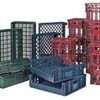 Bread and milk crates can be turned into a cosy sitting space with a few cushions. They can also be turned upside down and stacked, stepped on and used to support planks of wood for balancing. Children like to tie ropes on to them and pull them along the ground, and the holes are also useful for weaving. There is a large selection available on www.ebay.co.uk, or try the set of 20 Building Crates (£270) from www.earlyexcellence.co.uk. Cosy Direct offers a set of 30 H Crates (Class Pack), £240; a set of three Bread Crates (£24.60); and the Smaller Nesting Crates (6pk), £37.25.
Bread and milk crates can be turned into a cosy sitting space with a few cushions. They can also be turned upside down and stacked, stepped on and used to support planks of wood for balancing. Children like to tie ropes on to them and pull them along the ground, and the holes are also useful for weaving. There is a large selection available on www.ebay.co.uk, or try the set of 20 Building Crates (£270) from www.earlyexcellence.co.uk. Cosy Direct offers a set of 30 H Crates (Class Pack), £240; a set of three Bread Crates (£24.60); and the Smaller Nesting Crates (6pk), £37.25.
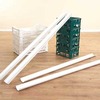 Guttering can be cut into manageable sizes, but children enjoy the satisfaction of being able to move big pieces themselves. Heavy-duty black guttering is the most robust and won't break when children jump on it or try to bend it in interesting ways. Light-coloured or transparent guttering provides more interest when food colouring is added to the water. It can be bought from most DIY shops with attachments for joining. Otherwise, Cosy Direct has a large selection of guttering, including Banksy's Less Leaky Pipes (16 pieces), £39.99; or 1 Metre Clear Guttering (pack of six), £29.95. Priced at £29.95, TTS Group (www.tts-group.co.uk) sells six lengths of white Plastic Guttering with three connectors; or try the Guttering, Pipes and Tubes water set (£245) from www.earlyexcellence.co.uk.
Guttering can be cut into manageable sizes, but children enjoy the satisfaction of being able to move big pieces themselves. Heavy-duty black guttering is the most robust and won't break when children jump on it or try to bend it in interesting ways. Light-coloured or transparent guttering provides more interest when food colouring is added to the water. It can be bought from most DIY shops with attachments for joining. Otherwise, Cosy Direct has a large selection of guttering, including Banksy's Less Leaky Pipes (16 pieces), £39.99; or 1 Metre Clear Guttering (pack of six), £29.95. Priced at £29.95, TTS Group (www.tts-group.co.uk) sells six lengths of white Plastic Guttering with three connectors; or try the Guttering, Pipes and Tubes water set (£245) from www.earlyexcellence.co.uk.
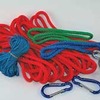 A rope is a versatile resource that can be used to tie around trees or posts, shaken and waved around, or simply just stood on or held. Ensure that it is used with adult supervision and that children know not to wrap it around themselves or each other. A rope attached above the children's heads or near head height is great for different pulling and pushing experiences. For more ideas on how to use a rope, visit Juliet Robertson's blog post on 'big rope play' - at creativestarlearning.co.uk/early-years-outdoors/big-rope-play - and see Let the Children Play's example of building a rope bridge - at www.letthechildrenplay.net/2010/11/building-rope-bridge.html. Buy a Set of Natural Ropes (£35) from www.earlyexcellence.co.uk, the Nylon Rope Set C - Corvus (£26.40) from www.mind stretchers.co.uk, or the Rope - Knot Tying (£5.94) from www.muddyfaces.co.uk. Poly Rope (from £1.75); Sisal Rope (£3.49); Climbing Style Rope (£2); and Rope to Tie Knots in for Climbing (£11.99) are all available to buy from Cosy Direct.
A rope is a versatile resource that can be used to tie around trees or posts, shaken and waved around, or simply just stood on or held. Ensure that it is used with adult supervision and that children know not to wrap it around themselves or each other. A rope attached above the children's heads or near head height is great for different pulling and pushing experiences. For more ideas on how to use a rope, visit Juliet Robertson's blog post on 'big rope play' - at creativestarlearning.co.uk/early-years-outdoors/big-rope-play - and see Let the Children Play's example of building a rope bridge - at www.letthechildrenplay.net/2010/11/building-rope-bridge.html. Buy a Set of Natural Ropes (£35) from www.earlyexcellence.co.uk, the Nylon Rope Set C - Corvus (£26.40) from www.mind stretchers.co.uk, or the Rope - Knot Tying (£5.94) from www.muddyfaces.co.uk. Poly Rope (from £1.75); Sisal Rope (£3.49); Climbing Style Rope (£2); and Rope to Tie Knots in for Climbing (£11.99) are all available to buy from Cosy Direct.
- Plastic pipes come in all shapes and sizes. The large plastic ones with corrugated exterior are usually found on building sites and are used to transport water underground. Large pipes are popular for rolling around, creating entrances to dens, crawling into or being used as planters. Ask at construction sites or buy from Cosy - try the Large Bore Pipes 450mm (£130); the Gigantic Pipe (£199); Soft Rubbery Tube (£4.49); or the Half Round Big Pipe (£65). Smaller pipes are popular for water play and rolling down items such as pebbles.
 Logs, stumps and wooden planks have a wide range of uses - from balancing beams to portable seating and construction. Try the Collection of Wood - 80 pieces (£299.99) from www.muddyfaces.co.uk. Cosy Direct offers Slippy Logs (2), £35; Jumbo Balancing Poles (£75); Rustic Plank Shorts (set of 4), £13.95; the Short Wooden Rollers (set of 6), £19.95; and Plastic Scaffolding Boards (£30), which can be used for transporting larger and/or heavier objects, such as a wheelbarrow into a sand pit, as part of children's construction play.
Logs, stumps and wooden planks have a wide range of uses - from balancing beams to portable seating and construction. Try the Collection of Wood - 80 pieces (£299.99) from www.muddyfaces.co.uk. Cosy Direct offers Slippy Logs (2), £35; Jumbo Balancing Poles (£75); Rustic Plank Shorts (set of 4), £13.95; the Short Wooden Rollers (set of 6), £19.95; and Plastic Scaffolding Boards (£30), which can be used for transporting larger and/or heavier objects, such as a wheelbarrow into a sand pit, as part of children's construction play.- Cable drums can be stacked, balanced, rolled, built with or used as tables. Try the Extra Large Cable Drum (£29.99), or the Recycled Cable Drum Construction Kit (£49.95), both from Cosy Direct.
- Nets are great for creating dens, hammocks or getting trapped inside. Try the Cameo Netting (£36.95) from www.muddyfaces.co.uk.
- Steering wheels can be attached to crates, boxes and fences for instant transport play. Find them from your local car scrap yard or buy an Attachable Steering Wheel or Ship's Attachable Steering Wheel (both £19.99) from Cosy Direct.
- Small-scale loose parts such as stones, pine cones, pebbles, shells, leaves and twigs can be found in the natural environment or bought from education suppliers or at 'creative reuse' suppliers (see www.scrapstoresuk.org). For ideas on play with natural small loose parts, see Niki Willows' booklet Keep It Simple, which can be downloaded from roundedandgrounded.blogspot.co.uk.
CASE STUDY: ABC NURSERY, CORSHAM, WILTSHIRE
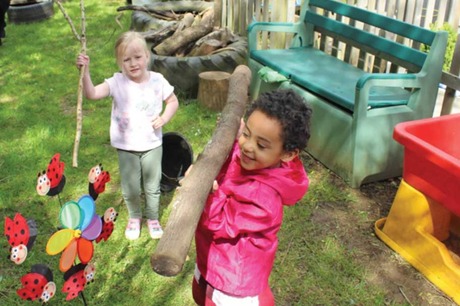
It was a big decision to remove all the plastic toys and structures from the ABC Nursery garden and replace them with a motley collection of loose parts, but it is one that nursery manager Tina Thomson doesn't regret.
She explains, 'I was initially concerned about what the parents would think about their children playing with planks of wood, guttering, tyres, ropes and lots of natural resources, but I shouldn't have been. Once the parents saw the joy in their children's faces - and the determination as the children lugged around tyres, wood and pieces of guttering to build fortresses, palaces or pirate ships - they were only too happy to welcome the initiative, and donate loose parts themselves.
'We went around businesses on the local trading estate and managed to get hold of drain pipes, fixings, down pipes, long cardboard tubes, masses of bubble wrap, small wooden crates and tyres of all sizes. The garage even delivered the tyres as they were glad to get rid of them. We purchased a wooden summer house, we filled some tyres with soil, plant pots, pebbles, sticks and twigs. We created a willow wall to allow the children to have an area in which they thought they couldn't be seen.
'Once the work was done, we stood back and let the children take over. They lift, carry and drag tyres and planks around, creating boats, fire engines, racing cars and trains, and they then take on roles and dream up the most brilliant imaginary play. An old rabbit hutch has become a mud kitchen - we hear them start off cooking Jamie Oliver-style dishes, and then the plot thickens with a mum, a dad going off to work and a baby going to sleep.
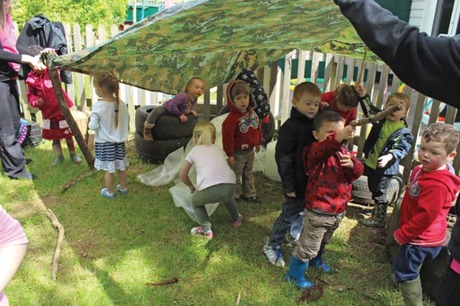
'The loose parts allow the garden to become something different every day. This depends on the child who is the ringleader for the day and what they decide. They use the resources in ways that we would never have envisaged. For example, we have a huge lorry tyre that the children like to climb into and walk around. One day, a child got a book and sat in the tyre with her legs dangling out; another child took her book and did the same. The children created their own cosy space and sat on the tyre discussing their books. The tyre is now used for outdoor story sessions.
'Another example is when the children dragged the tyres into a line and sat inside them. The leader drove the "bus" to the seaside and then the children all got out and had "ice-creams", which they "bought" from the summer house, and a picnic.
'I love to watch the children play with loose parts. It is fascinating to see what they do with the materials and how their minds work. Even the children who are quiet and don't interact with other children inside, work collaboratively outside in this environment. The possibilities are endless.'
MORE INFORMATION
- Juliet Robertson's blog on loose parts is at creativestarlearning.co.uk/early-years-outdoors/are-loose-parts-toys
- Let the Children Play has advice at www.letthechildrenplay.net/2010/01/ how-children-use-outdoor-play-spaces.html
- Simon Nicholson's 1971 paper The Theory of Loose Parts is available at ojs.lboro.ac.uk/ojs/index.php/SDEC/article/view/1204/1171
- The Little Book of Free and Found by J Mountain (2014), Featherstone Education.









